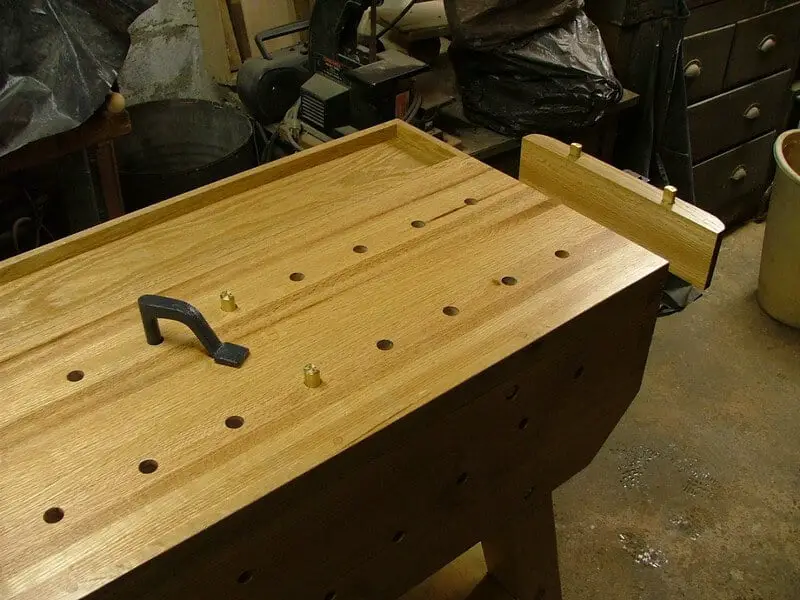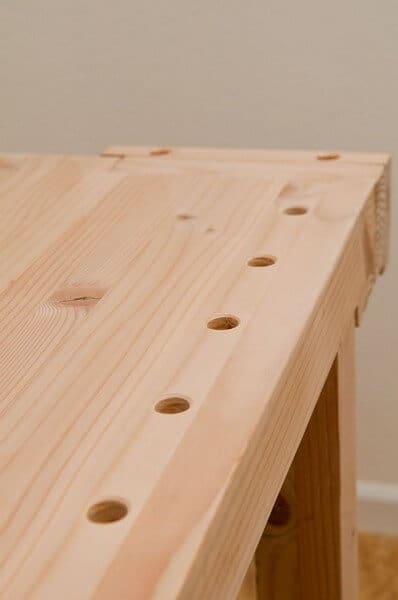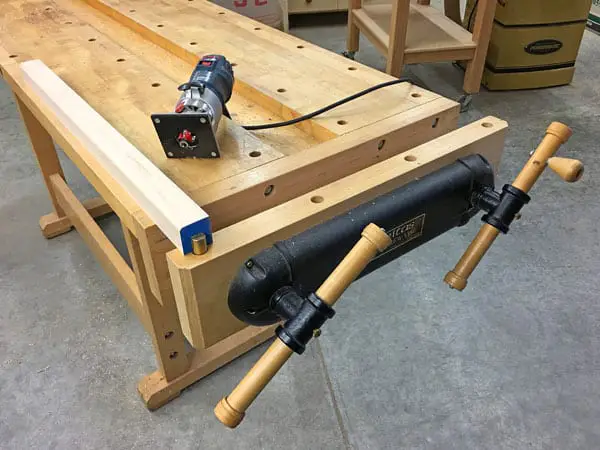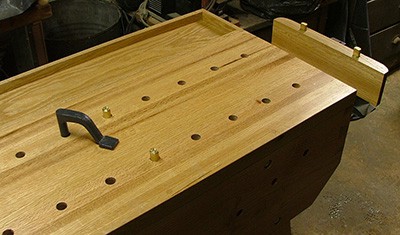If you are either in the process of getting a woodworking bench or have just purchased one, you may have taken notice of many holes built into the surface of the woodworking bench. This is not a cause for concern, as the holes in the woodworking bench have a utility value. Why do woodworking benches have holes?
The holes in woodworking benches serve the purpose of allowing the user to secure workpieces via differing types of clamps. These holes can even allow clamps and other accessories, called bench dogs, to be used to secure a workpiece in lieu of a vise.
The holes in woodworking benches save woodworkers many logistical headaches. They are advantageous for several reasons that will be discussed in further detail in this article. You will learn about how to utilize the holes in your woodworking bench, referred to as “dog holes.”
Why Do Woodworking Benches Have Holes?

The holes seen often on woodworking benches are called dog holes. They exist for the purpose of holding bench dogs or clamps that serve the valuable service of holding a workpiece in place. The number of dog holes varies by the bench.
Some woodworking benches come with dog holes already installed, while others leave these decisions up to the owner of the workbench. There are numerous benefits to having dog holes in your workbench, as will be discussed in further detail below.

Dog Holes Allow You To Hold Your Workpiece
The dog holes in a workbench allow you to clamp workpieces into place. Simply applying extra pressure by hand is not enough to keep workpieces in place. There are a lot of scenarios in which even the slightest accidental nudge will cause you to cut too deeply into the piece.
One such example of a situation in which you would want maximum control over the piece would be a situation in which you were using a planning tool to scrape against the surface of a workpiece. You can keep the workpiece in place by setting it against a bench dog. Just one slip of the hand could lead to an uneven cut if the workpiece is not secured.
The dog holes in the bench can be either square or rounded. Square dog holes come standard, but rounded dog holes certainly aren’t unusual. Many woodworkers favor round dog holes because they are simple to make in case that you are making your own workbench.
Square dog holes can serve a purpose as well. You will learn more about the advantages associated with both types of dog holes in the next section.
I wrote this article explaining what the 10 best timber is to build a workbench. The results may shock you!
Which Is Better? Square Dog Holes Or Round Dog Holes?
Round dog holes certainly are easier to make than square dog holes are and are generally more favored among woodworkers. However, the square dog holes can offer several advantages versus the round dog holes that are so common in DIY workbenches.
One advantage of square dog holes is that a square dog will not rotate within its hole in the same way that a round dog will. There is always at least some potential for a round dog to twist out of place at an opportune time, although proper sizing can help reduce the chance that this will happen.
Square dog holes are most advantageous for those who make furniture. Many furniture pieces feature square workpieces. Take for example a cabinet assembly. You do not want any rotational motion to occur when you are working on such a piece. If a piece does contain curved edges, then the round dog holes will better service your needs.
Round dog holes are also the better option if you anticipate finding yourself in circumstances where you would have to clamp a workpiece that is slightly angled. It will be easier to clamp your workpiece on to the table in such situations because the round bench dogs have a little more give to them.
Workbenches with round dog holes are pretty popular, as is the case with this Black & Decker Portable Workbench. This means that it can be easier to find suitable accessories for workbenches with round dog holes than it is with workbenches that have square dog holes. This claim can be supported with a quick search of workbench dog hole accessories online.
Dog Holes Can Also Be Used To Secure Holdfasts
Dog holes are for more than just holding bench dogs. You can further secure your workpiece by placing some variety of a holdfast in the dog hole. Holdfasts include any kind of tool, such as a clamp or vise, that will hold your workpiece against the table with much more security than a hand or elbow.
If your workbench has dog holes, then you are no longer limited to using vise grips or holdfast clamps that sit along the edge of the workbench. The dog hole can easily hold a workpiece right against the center of a workbench, not just the edges.
One of the most popular workbench dog hole accessories is a holding clamp designed to hold your workpiece in place from the center of the table. Take for example this hold fast that I use. The clamp fits within a ¾” round hole- which comes as a pretty standard dog hole size. The clamp can be adjusted all the way up to a height 6.5” above the table surface.
The clamp can also be rotated 360 degrees. You can see why many woodworkers prefer rounded dog-holes for accessories like this clamp. The clamps are generally more versatile when they can be added to round dog holes because they can easily be rotated. You may want to clamp an item from the opposite side while you work on the piece, for logistical reasons.
How Can I Make My Own Dog-Holes In My Workbench?

Making your own woodworking bench can be a rewarding experience. It allows you to customize your workbench in a way that best suits your uses. Here I will cover the methods used to make a dog hole strip on your workbench. You may even consider using these methods to further customize a woodworking bench that already has a dog hole strip on it.
Tools That You May Need
You can easily add dog holes to your woodworking bench via the use of hand tools that you may already have on hand in your workshop. In the case that you do not have any of these tools on hand, I have provided links to a page where you can find affordable options.
Tools you may need include:
- Backsaw
- Chisel
- Miter Gauge (if you are using a table saw)
- Dado Head (if you are using a table saw or radial arm saw)
- Router (there is a method for cutting out a dog hole that involves using a router)
Whichever method you decide to use, you can find detailed instructions from educational woodworking resources such as this one. Keep in mind that you will need to angle the dog-hole properly. The dog hole should be constructed at an 88-degree angle.
You will also need to cut out extra space in the dog hole to allow enough room in front of the slot for the dog to be retracted partially or fully when you want it to be out of the way. An easy way to accomplish this would be to chop out the extra area using a chisel.
I cannot stress how important it is to plan things out before you do them. The dog holes need to be spaced in such a manner that they do not interfere with hardware and pieces of wood that are clamped along the edge of the workbench.
Dog holes are typically ¾” inches in diameter and spread out 2-3 inches apart from each other. You will find that most bench dogs and clamp accessories are sized for ¾ inch dog holes. It may be difficult to find very many accessories that deviate from this norm.
You will want to avoid placing dog holes to close together. If you are customizing your own workbench you may even consider adding dog holes that are square. As mentioned earlier, dog holes that are square are often utilized by those who are making furniture. The round holes are simpler to make though and serve a large variety of uses.
Does My Workbench Need Dog Holes?
Cutting out your own dog holes can be tedious work and workbenches that already have dog holes may seem a little pricey. While there are some woodworkers who genuinely don’t need dog holes in their workbench, you should be made aware of the numerous benefits that dog holes have to offer woodworkers, particularly if they are operating from a shop where space is at a premium.
Bench Dogs Help You Get The Most Out Of Your Bench Space
Woodworkers who are confined to tight spaces will notice the biggest difference when they start using bench dogs. Bench dogs allow you to secure workpieces in the center of the table. You will not be limited to clamping your workpieces along a vise located at the edge of the table.
You may find yourself working on multiple projects at once, or on a project that has a lot of different pieces. The bench dog allows you to keep all these workpieces on your table at once. If you notice a lot of empty space going to waste, then the best solution will be to install a few dog holes.
Extra Security
Bench dogs and clamps also provide added security for larger pieces that you may be working on by allowing them to be clamped across the entire surface area of the table. If you are only using a vise, then you will only be able to clamp a large workpiece down at its outer edge.
Versatility
Bench dogs serve the woodworker in ways that vises at the edge of the table. If you need a clamp that can pivot and rotate while you are working on a curved piece, then a round-hole bench dog will service your needs excellently. Authors at Wood Magazine go as far as to say that bench dogs are “man’s best friend” – and it’s more than just a play on words.
Bench dogs can also be designed to contain springs in their structure that make the height of the dog adjustable. These types of bench dogs can be used to secure a diverse range of workpieces. A good example of a bench dog with an adjustable height is the Rockler Round Bench Dog. This bench dog has a spring in it that allows the user to adjust the height as necessary.
You Don’t Necessarily Need A Tail Vise

Bench dogs can be a real plus for woodworkers who do not already own a vise for the edge of the table. If you already own a vise, bench dogs or dog hole clamps may not be as advantageous. If you do not have a vise, you should look into the many applications of dog holes in woodworking benches.
You can use bench dogs to secure a board of wood for planning. This can be accomplished by centering a square piece over a bench dog and then driving a wedge between the board and the square piece. The square piece should have a hole cut through the center that will allow you to embed the bench dog within the center hole.
Once you drive the wedge between the square piece and the board, the entire assembly will be secure enough for you to plane the board without having to worry about it moving on you. You can see how well this works in this video. The size of the wedge depends upon personal preference. The square piece should be large enough to have 1-inch and 2-inch lengths from the edge of the center hole to the edge of the piece.
Bench Dogs Can Be More Affordable
Although vises serve as the more secure clamping option under many circumstances, they can also come at a higher cost than bench dogs. Even these adjustable steel bench dogs are relatively affordable. Top-of-the-line woodworking vises can be quite costly, as is evidenced by the price tag on this vise.
While it’s hard to be able to completely replace the functionality of a good vise, it is certainly practical for the DIY woodworker to seek out the help of bench dogs, as is shown in a section above detailing how bench dogs can be utilized in the absence of a woodworking vise.
Many woodworkers even make their own bench dogs from wood that they have lying around. There are a variety of materials used for making DIY bench dogs, as is seen in this article appearing in Wood Magazine. These activities always bring up an age-old debate amongst avid woodworkers regarding which type of wood or other material makes the best bench dogs.
Which Material Should My Bench Dog Be Made Out Of?
You will find that bench dogs are made out of a variety of materials: many DIY bench dogs are wooden, some are plastic and others are made of metal. Some woodworkers do have a preference for the type of material that their bench dogs are made out of, as can be seen in this article appearing in The English Woodworker.
Wood and plastic bench dogs are usually more affordable than steel bench dogs. Many DIY woodworkers use wood bench dogs because they can make them with equipment and materials that they have on hand. More often than not, these bench dogs will do the trick. The downside is durability. You may end up nicking and having to replace wooden bench dogs quite frequently if you are rough on them.
Steel bench dogs are clearly the most durable. They will stand the test of time. It should be a while before you have to replace a steel bench dog. Some woodworkers avoid steel bench dogs out of concern that they will damage equipment. You could inadvertently run your planning tool across the top of the bench dog and damage it. At the very least the blade will need to be sharpened.
There is no bench dog material that is clearly above the rest. Bench dogs are an essential item for woodworkers, particularly for those who do not own a vise. The bench dog serves the critical purpose of keeping the workpiece in place while it is being attended to.




